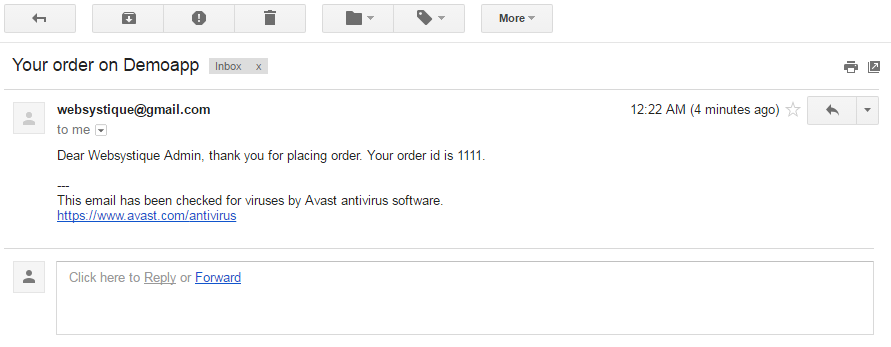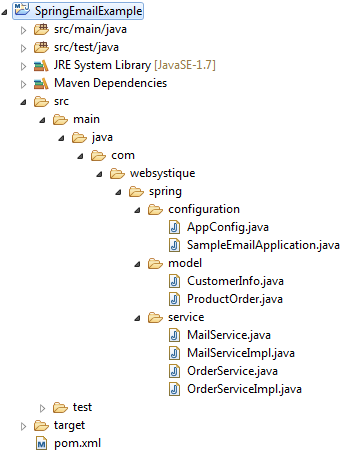Spring provides first-class support for sending Emails. Spring comes with utility libraries which abstracts away the complexities of the underlying mailing system, provides super-simple API to use in your application to send emails. Let’s get going.
- Spring Boot+AngularJS+Spring Data+Hibernate+MySQL CRUD App
- Spring Boot WAR deployment example
- Spring Boot REST API Tutorial
- Spring Boot Introduction + Hello World Example
- Secure Spring REST API using OAuth2
- AngularJS+Spring Security using Basic Authentication
- Secure Spring REST API using Basic Authentication
- Spring 4 Caching Annotations Tutorial
- Spring 4 Cache Tutorial with EhCache
- Spring 4 MVC+JPA2+Hibernate Many-to-many Example
- Spring MVC 4+AngularJS Example
- Spring 4 Email Template Library Example
- Spring 4 Email With Attachment Tutorial
- Spring MVC 4+JMS+ActiveMQ Integration Example
- Spring 4+JMS+ActiveMQ @JmsLister @EnableJms Example
- Spring 4+JMS+ActiveMQ Integration Example
- Spring MVC 4+Hibernate 4 Many-to-many JSP Example
- Spring MVC 4+Hibernate 4+MySQL+Maven integration example using annotations
- Spring MVC4 FileUpload-Download Hibernate+MySQL Example
- TestNG Mockito Integration Example Stubbing Void Methods
- Maven surefire plugin and TestNG Example
- Spring MVC 4 Form Validation and Resource Handling
Spring Email support is built upon JavaMail API, which must be found on class path. In our example, we did so by including APIjavax.mail.javax.mail-api & implementation javax.mail.mail in our pom.xml. Spring’s EMail support related stuff is packaged under spring-context-support.
Below is the pom.xml for this post.
<project xmlns="http://maven.apache.org/POM/4.0.0" xmlns:xsi="http://www.w3.org/2001/XMLSchema-instance"
xsi:schemaLocation="http://maven.apache.org/POM/4.0.0 http://maven.apache.org/xsd/maven-4.0.0.xsd">
<modelVersion>4.0.0</modelVersion>
<groupId>com.websystique.spring</groupId>
<artifactId>SpringEmailExample</artifactId>
<version>1.0.0</version>
<packaging>jar</packaging>
<name>SpringEmailExample</name>
<properties>
<springframework.version>4.3.0.RELEASE</springframework.version>
</properties>
<dependencies>
<dependency>
<groupId>org.springframework</groupId>
<artifactId>spring-core</artifactId>
<version>${springframework.version}</version>
</dependency>
<dependency>
<groupId>org.springframework</groupId>
<artifactId>spring-context</artifactId>
<version>${springframework.version}</version>
</dependency>
<!-- All Mail related stuff + Much more-->
<dependency>
<groupId>org.springframework</groupId>
<artifactId>spring-context-support</artifactId>
<version>${springframework.version}</version>
</dependency>
<!-- JavaMail-->
<dependency>
<groupId>javax.mail</groupId>
<artifactId>javax.mail-api</artifactId>
<version>1.5.5</version>
</dependency>
<dependency>
<groupId>javax.mail</groupId>
<artifactId>mail</artifactId>
<version>1.4.7</version>
</dependency>
</dependencies>
<build>
<plugins>
<plugin>
<groupId>org.apache.maven.plugins</groupId>
<artifactId>maven-compiler-plugin</artifactId>
<version>3.2</version>
<configuration>
<source>1.7</source>
<target>1.7</target>
</configuration>
</plugin>
</plugins>
</build>
</project>
Spring provides two primary interfaces for sending emails:
-
MailSender: handy for sending simple mail messages, providing ‘from’,’to’,’cc’,’bcc’,’subject’ & other mail properties. -
JavaMailSender: Extends MailSender, adds specialized JavaMail features such as MIME message support.
Spring’s JavaMailSenderImpl is production implementation of the JavaMailSender interface which can be used for host configuration as well as connection setup. Shown below is our configuration class, using Gmail SMTP connection settings to send emails using gmail.
package com.websystique.spring.configuration;
import java.util.Properties;
import org.springframework.context.annotation.Bean;
import org.springframework.context.annotation.ComponentScan;
import org.springframework.context.annotation.Configuration;
import org.springframework.mail.javamail.JavaMailSender;
import org.springframework.mail.javamail.JavaMailSenderImpl;
@Configuration
@ComponentScan(basePackages = "com.websystique.spring")
public class AppConfig {
//Put Other Application configuration here.
@Bean
public JavaMailSender getMailSender(){
JavaMailSenderImpl mailSender = new JavaMailSenderImpl();
//Using gmail
mailSender.setHost("smtp.gmail.com");
mailSender.setPort(587);
mailSender.setUsername("Your-gmail-id");
mailSender.setPassword("Your-gmail-password");
Properties javaMailProperties = new Properties();
javaMailProperties.put("mail.smtp.starttls.enable", "true");
javaMailProperties.put("mail.smtp.auth", "true");
javaMailProperties.put("mail.transport.protocol", "smtp");
javaMailProperties.put("mail.debug", "true");//Prints out everything on screen
mailSender.setJavaMailProperties(javaMailProperties);
return mailSender;
}
}
You should adapt above configuration based on your Email provider settings and credentials. Once you got JavaMailSender ready, only thing left is to prepare the actual message itself and then send it using JavaMailSender.
To prepare the message itself, spring provides[among several other possibilities] a handy Callback MimeMessagePreparator interface, which can be used for the preparation of JavaMail MIME messages. This preparator can then be passed to javaMailSender while calling send to actually send the message.
Below is the mail-sending logic. Take special note of recipient, which is the email id of recipient.
package com.websystique.spring.service;
import javax.mail.Message;
import javax.mail.internet.InternetAddress;
import javax.mail.internet.MimeMessage;
import org.springframework.beans.factory.annotation.Autowired;
import org.springframework.mail.MailException;
import org.springframework.mail.javamail.JavaMailSender;
import org.springframework.mail.javamail.MimeMessagePreparator;
import org.springframework.stereotype.Service;
import com.websystique.spring.model.ProductOrder;
@Service("mailService")
public class MailServiceImpl implements MailService {
@Autowired
JavaMailSender mailSender;
@Override
public void sendEmail(Object object) {
ProductOrder order = (ProductOrder) object;
MimeMessagePreparator preparator = getMessagePreparator(order);
try {
mailSender.send(preparator);
System.out.println("Message Send...Hurrey");
} catch (MailException ex) {
System.err.println(ex.getMessage());
}
}
private MimeMessagePreparator getMessagePreparator(final ProductOrder order) {
MimeMessagePreparator preparator = new MimeMessagePreparator() {
public void prepare(MimeMessage mimeMessage) throws Exception {
mimeMessage.setFrom("customerserivces@yourshop.com");
mimeMessage.setRecipient(Message.RecipientType.TO,
new InternetAddress(order.getCustomerInfo().getEmail()));
mimeMessage.setText("Dear " + order.getCustomerInfo().getName()
+ ", thank you for placing order. Your order id is " + order.getOrderId() + ".");
mimeMessage.setSubject("Your order on Demoapp");
}
};
return preparator;
}
}
Let’s write a Main to actually see the email sending in action. Shown below is the Main for this example:
package com.websystique.spring.configuration;
import org.springframework.context.annotation.AnnotationConfigApplicationContext;
import org.springframework.context.support.AbstractApplicationContext;
import com.websystique.spring.model.CustomerInfo;
import com.websystique.spring.model.ProductOrder;
import com.websystique.spring.service.OrderService;
public class SampleEmailApplication {
public static void main(String[] args) {
AbstractApplicationContext context = new AnnotationConfigApplicationContext(AppConfig.class);
OrderService orderService = (OrderService) context.getBean("orderService");
orderService.sendOrderConfirmation(getDummyOrder());
((AbstractApplicationContext) context).close();
}
public static ProductOrder getDummyOrder(){
ProductOrder order = new ProductOrder();
order.setOrderId("1111");
order.setProductName("Thinkpad T510");
order.setStatus("confirmed");
CustomerInfo customerInfo = new CustomerInfo();
customerInfo.setName("Websystique Admin");
customerInfo.setAddress("WallStreet");
customerInfo.setEmail("websystique@gmail.com");
order.setCustomerInfo(customerInfo);
return order;
}
}
Build & Execute
Run the mail program, and check your [customer] mailbox. You should see new message.

And the execution logs are:
Jul 05, 2016 12:22:53 AM org.springframework.context.annotation.AnnotationConfigApplicationContext prepareRefresh
INFO: Refreshing org.springframework.context.annotation.AnnotationConfigApplicationContext@4ec4f498: startup date [Tue Jul 05 00:22:53 CEST 2016]; root of context hierarchy
DEBUG: JavaMail version 1.5.5
DEBUG: successfully loaded resource: /META-INF/javamail.default.providers
DEBUG: Tables of loaded providers
DEBUG: Providers Listed By Class Name: {com.sun.mail.smtp.SMTPSSLTransport=javax.mail.Provider[TRANSPORT,smtps,com.sun.mail.smtp.SMTPSSLTransport,Oracle], com.sun.mail.smtp.SMTPTransport=javax.mail.Provider[TRANSPORT,smtp,com.sun.mail.smtp.SMTPTransport,Oracle], com.sun.mail.imap.IMAPSSLStore=javax.mail.Provider[STORE,imaps,com.sun.mail.imap.IMAPSSLStore,Oracle], com.sun.mail.pop3.POP3SSLStore=javax.mail.Provider[STORE,pop3s,com.sun.mail.pop3.POP3SSLStore,Oracle], com.sun.mail.imap.IMAPStore=javax.mail.Provider[STORE,imap,com.sun.mail.imap.IMAPStore,Oracle], com.sun.mail.pop3.POP3Store=javax.mail.Provider[STORE,pop3,com.sun.mail.pop3.POP3Store,Oracle]}
DEBUG: Providers Listed By Protocol: {imaps=javax.mail.Provider[STORE,imaps,com.sun.mail.imap.IMAPSSLStore,Oracle], imap=javax.mail.Provider[STORE,imap,com.sun.mail.imap.IMAPStore,Oracle], smtps=javax.mail.Provider[TRANSPORT,smtps,com.sun.mail.smtp.SMTPSSLTransport,Oracle], pop3=javax.mail.Provider[STORE,pop3,com.sun.mail.pop3.POP3Store,Oracle], pop3s=javax.mail.Provider[STORE,pop3s,com.sun.mail.pop3.POP3SSLStore,Oracle], smtp=javax.mail.Provider[TRANSPORT,smtp,com.sun.mail.smtp.SMTPTransport,Oracle]}
DEBUG: successfully loaded resource: /META-INF/javamail.default.address.map
DEBUG: getProvider() returning javax.mail.Provider[TRANSPORT,smtp,com.sun.mail.smtp.SMTPTransport,Oracle]
DEBUG SMTP: useEhlo true, useAuth true
DEBUG SMTP: trying to connect to host "smtp.gmail.com", port 587, isSSL false
220 smtp.gmail.com ESMTP t67sm6893011wma.1 - gsmtp
DEBUG SMTP: connected to host "smtp.gmail.com", port: 587
EHLO 192.168.1.3
250-smtp.gmail.com at your service, [81.243.87.175]
250-SIZE 35882577
250-8BITMIME
250-STARTTLS
250-ENHANCEDSTATUSCODES
250-PIPELINING
250 SMTPUTF8
DEBUG SMTP: Found extension "SIZE", arg "35882577"
DEBUG SMTP: Found extension "8BITMIME", arg ""
DEBUG SMTP: Found extension "STARTTLS", arg ""
DEBUG SMTP: Found extension "ENHANCEDSTATUSCODES", arg ""
DEBUG SMTP: Found extension "PIPELINING", arg ""
DEBUG SMTP: Found extension "SMTPUTF8", arg ""
STARTTLS
220 2.0.0 Ready to start TLS
EHLO 192.168.1.3
250-smtp.gmail.com at your service, [81.243.87.175]
250-SIZE 35882577
250-8BITMIME
250-AUTH LOGIN PLAIN XOAUTH2 PLAIN-CLIENTTOKEN OAUTHBEARER XOAUTH
250-ENHANCEDSTATUSCODES
250-PIPELINING
250 SMTPUTF8
DEBUG SMTP: Found extension "SIZE", arg "35882577"
DEBUG SMTP: Found extension "8BITMIME", arg ""
DEBUG SMTP: Found extension "AUTH", arg "LOGIN PLAIN XOAUTH2 PLAIN-CLIENTTOKEN OAUTHBEARER XOAUTH"
DEBUG SMTP: Found extension "ENHANCEDSTATUSCODES", arg ""
DEBUG SMTP: Found extension "PIPELINING", arg ""
DEBUG SMTP: Found extension "SMTPUTF8", arg ""
DEBUG SMTP: Attempt to authenticate using mechanisms: LOGIN PLAIN DIGEST-MD5 NTLM
DEBUG SMTP: AUTH LOGIN command trace suppressed
DEBUG SMTP: AUTH LOGIN succeeded
DEBUG SMTP: use8bit false
MAIL FROM:<customerserivces@yourshop.com>
250 2.1.0 OK t67sm6893011wma.1 - gsmtp
RCPT TO:<websystique@gmail.com>
250 2.1.5 OK t67sm6893011wma.1 - gsmtp
DEBUG SMTP: Verified Addresses
DEBUG SMTP: websystique@gmail.com
DATA
354 Go ahead t67sm6893011wma.1 - gsmtp
Date: Tue, 5 Jul 2016 00:22:57 +0200 (CEST)
From: customerserivces@yourshop.com
To: websystique@gmail.com
Message-ID: <68026518.0.1467670977746@dragon>
Subject: Your order on Demoapp
MIME-Version: 1.0
Content-Type: text/plain; charset=us-ascii
Content-Transfer-Encoding: 7bit
Dear Websystique Admin, thank you for placing order. Your order id is 1111.
.
250 2.0.0 OK 1467670979 t67sm6893011wma.1 - gsmtp
QUIT
221 2.0.0 closing connection t67sm6893011wma.1 - gsmtp
Message Send...Hurrey
Jul 05, 2016 12:22:59 AM org.springframework.context.annotation.AnnotationConfigApplicationContext doClose
INFO: Closing org.springframework.context.annotation.AnnotationConfigApplicationContext@4ec4f498: startup date [Tue Jul 05 00:22:53 CEST 2016]; root of context hierarchy
That’s it. For the sake of completeness, shown below are the remaining classes from this example.
package com.websystique.spring.service;
import org.springframework.beans.factory.annotation.Autowired;
import org.springframework.stereotype.Service;
import com.websystique.spring.model.ProductOrder;
@Service("orderService")
public class OrderServiceImpl implements OrderService{
@Autowired
MailService mailService;
@Override
public void sendOrderConfirmation(ProductOrder productOrder) {
mailService.sendEmail(productOrder);
}
}
package com.websystique.spring.service;
import com.websystique.spring.model.ProductOrder;
public interface OrderService {
public void sendOrderConfirmation(ProductOrder productOrder);
}
package com.websystique.spring.service;
public interface MailService {
public void sendEmail(final Object object);
}
package com.websystique.spring.model;
public class CustomerInfo {
private String name;
private String address;
private String email;
public String getName() {
return name;
}
public void setName(String name) {
this.name = name;
}
public String getAddress() {
return address;
}
public void setAddress(String address) {
this.address = address;
}
public String getEmail() {
return email;
}
public void setEmail(String email) {
this.email = email;
}
@Override
public String toString() {
return "CustomerInfo [name=" + name + ", address=" + address + ", email=" + email + "]";
}
}
package com.websystique.spring.model;
public class ProductOrder {
private String orderId;
private String productName;
private String status;
private CustomerInfo customerInfo;
public String getOrderId() {
return orderId;
}
public void setOrderId(String orderId) {
this.orderId = orderId;
}
public String getProductName() {
return productName;
}
public void setProductName(String productName) {
this.productName = productName;
}
public String getStatus() {
return status;
}
public void setStatus(String status) {
this.status = status;
}
public CustomerInfo getCustomerInfo() {
return customerInfo;
}
public void setCustomerInfo(CustomerInfo customerInfo) {
this.customerInfo = customerInfo;
}
@Override
public String toString() {
return "ProductOrder [orderId=" + orderId + ", productName=" + productName + ", status=" + status
+ ", customerInfo=" + customerInfo + "]";
}
}
And finally the directory structure.

That’s it. As we saw, it’s rather easy to use Spring’s email support in your own application. Feel free to comment, and suggest improvements.
Download Source Code
References
If you like tutorials on this site, why not take a step further and connect me on Facebook , Google Plus & Twitter as well? I would love to hear your thoughts on these articles, it will help improve further our learning process.